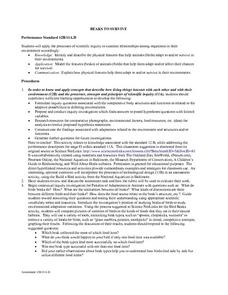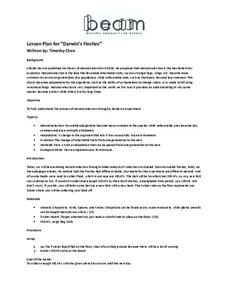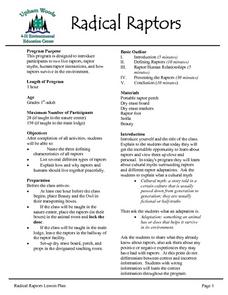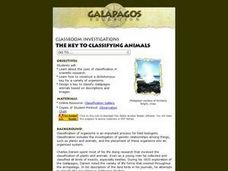Curated OER
Dancing Flamingos
Students perform a number of activities that mimic flamingo actions and displays. The class discusses why animals behave in certain ways, and how behavioral adaptations help animals to survive.
Curated OER
Best Nest Builders
Students construct a nest out of mud, string, sticks, and grass using only two fingers or two popsicle sticks to simulate a bird building a nest. They compare/contrast pictures of various bird nests and draw the differences between the...
Curated OER
Beaks To Survive
High schoolers discuss and identify the types of adaptations that are made by different organisms in order for them to survive. In groups, they describe the features of beaks and discuss how it affects their chances for survival. They...
Curated OER
Kites
Students practice estimating and comparing measurements using yards, feet, and inches. They make comparisons about kites and a variety of measurements. Afterwards, they complete an activity sheet and draw a bird kite with long wings and...
Berkeley Engineering and Mentors
Darwin's Finches
Try a twist on the old finch beak and chopsticks activity by using M&Ms on a Twister mat. Spoons, knives, forks, and chopsticks represent beaks and are randomly assigned to your little birds, who must collect as much food as possible...
Curated OER
Radical Raptors
Young scholars are introduced to raptors and their role in the environment. They identify three characteristics of raptors and list several types of raptors found in nature. They discuss their positive and negative experiences with...
Curated OER
The Shape of Things
Sixth graders read and discuss information regarding the shape and attributes of an eggshell. In this shape of things activity, 6th graders gather relevant information that pertains to the incubation and formation of an eggshell. ...
Curated OER
Toothpick Worms
Learners investigate camouflage. In this science lesson plan, students experience the role of color in camouflage as they complete a hands-on activity.
Curated OER
Adaptable Mandibles
Students define adaptation and highlight example of adaptation in birds and other animals. They study feeding techniques of seabirds and investigate the effect that trash has on wildlife.
Curated OER
Seabird Survival Adaptation Card Game
Students study seabirds and how they have adapted to their environments. In this activity based lesson plan students will play a card game that will allow them to have a better understanding of seabirds and their adaptations.
Curated OER
FLY HIGH!!!
Students create their own bird study in their own schoolyard using the scientific method (see Testing a Hypothesis in Join the Project). Students do research in the library, at a local college, or on the Internet to determine the...
Curated OER
Natural Selection and the Peppered Moth
Students study natural selection and its process in the peppered moth. For this evolution lesson, students read about the concept of natural selection as suggested by Charles Darwin. Students then complete a natural selection simulation...
Curated OER
The Key To Classifying Animals
Explorers of the environment construct a dichotomous key for a variety of organisms and design a key to classify Galapagos animals based on descriptions and images. The lesson includes a link to an animal gallery and the worksheet for...
Curated OER
The Great Pollinators
Students discover the reproductive parts of a plant. In this biology lesson, students identify and categorize several different plants they dissect in class. Students record their information using a data chart.
Curated OER
Introduction to Adaptation
Tenth graders observe collections of specimens and discuss their answers to provided questions. They explore common ancestry, homology, analogy, adaptive radiation, and evolution, while formulating creative answers based on their...
Curated OER
Wetland Ecosystems: Non-living and Living Components and Brine Shrimp
Students explore wetland ecosystems. In this wetland lesson, students discuss and observe salt ponds and the organisms that live there. They explain how abiotic and biotic factors of species are important to survival.
Curated OER
A Newspaper?
Sixth graders use newspapers to investigate fractions. They work in small groups to categorize articles, measure them with the grid transparency, and calculate the values represented. Afterward, they write a reflective essay on the role...
Curated OER
Discovering Owls
Students are introduced to different types of owls and owl pellets. They list several adaptations that benefit the owls. Students identify the various species of owl that live in Wisconsin. Students discuss owl pellets and identify the...
Curated OER
Tundra Swan Fun Facts
Students read about the characteristics of tundra swan. In this tundra swan instructional activity, students understand the characteristics of the tundra swan and complete worksheets related to the tundra swan.
Curated OER
Animals who eat Rice
Students read a story and answer questions. In this reading for understanding lesson, students read a story and answer questions. Students also draw pictures of the story to help comprehension.
Curated OER
Inexpensive Marrionette Puppet
Young scholars follow directions to create a marionette puppet using Styrofoam balls, fishing line and feathers. They practice making it walk, dance, eat, sit, and walk backwards.
Curated OER
Fun With Imogene: Let's Use Our Imagination!
Students research animal characteristics and use their imaginations to tell about what it would be like to wake up one morning and find that they have some animal characteristic. They read Imogene's Antlers by David Small.
Curated OER
Who Am I? - Locomotor Skills
Learners discuss the meaning of the word locomotion and the different ways that they use locomotor skills.
Curated OER
Rainforest Introduction
First graders create parrots and butterflies by using art materials to introduce them to rainforest animals. In this art lesson plan, 1st graders then use these animals to create a class rainforest.

























